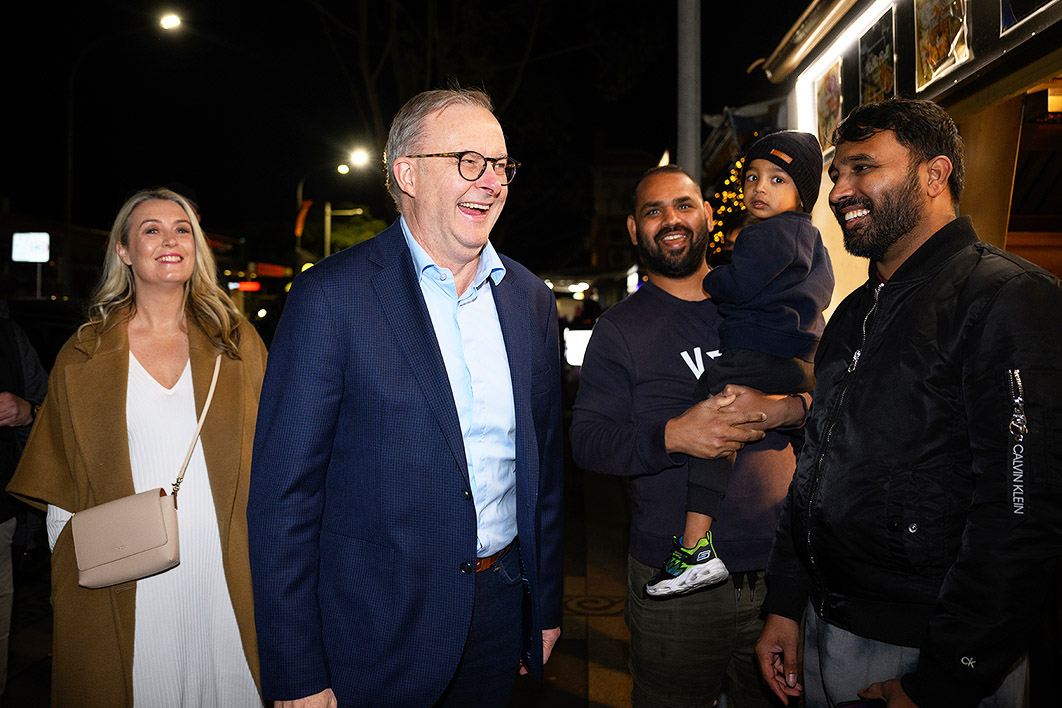
Newspoll, published and paid for by the Australian, is the voice of the people most clearly heard in Canberra and most widely heeded either side of an election. This has been true since the 1980s, not only between elections but also in the lead-up to referendums.
Apart from its election record, which for the last thirty years has been the gold standard, Newspoll’s status derives from its longevity (Roy Morgan Research is the only polling brand that has been around for longer), where it is published (an upmarket newspaper read by most federal politicians, with an online presence featuring excellent graphics) and its frequency (unmatched). Poll addicts crave nothing more than a known quantity, easily accessible trend data and a regular fix.
It’s not just the percentages Newspoll generates that matter; it is also the way the Australian interprets the figures. How much the figures themselves matter, and how much the Australian’s interpretation matters, is difficult to say. Both are recycled by politicians and journalists, among others, without much thought being given to whether they make sense.
In the latest poll, conducted 12–15 July, Labor’s primary vote was down (from 38 per cent, 16–24 June, to 36 per cent), as was the Coalition’s (35 per cent to 34 per cent), but Labor’s two-party lead grew from 54–46 to 55–45 — rounded, as are all Newspoll figures, to the nearest integer. As Adrian Beaumont noted in the Conversation, Labor “may have been unlucky” in the rounding of the two previous Newspolls but it “was probably lucky” this time.
At the Australian, the judgement of long-time political editor Simon Benson was unequivocal. Focusing on the fall in Labor’s first-preference support rather than the rise in its two-party share, he declared: “Labor’s honeymoon is officially over.” “Officially”? It was as if Newspoll should be recognised as having the same sort of status as the Australian Bureau of Statistics, say, or the Australian Electoral Commission. If, as Phillip Coorey observed, “the latest Newspoll” was merely “the latest to declare the government’s honeymoon over” (it was the Australian not Newspoll that declared it) then it was uniquely the Australian that made it “official.”
Benson took it for granted that Labor’s “honeymoon” came to an end once its first-preference support declined to a post-election “low” by an amount Benson judged to be significant. No matter that this support for Labor was still well above the 32.6 per cent (primary) or 52.1 per cent (two-party) vote recorded at the May 2022 election. The “honeymoon” had ended, and that was now “official.”
An electoral honeymoon, unlike the real thing, can end it seems — or begin to end — at whatever moment a poll-watcher chooses. Last September, when Labor’s two-party support in Newspoll reached 57 per cent — just two points higher than its current level — and its primary support stood at 37 per cent (one point ahead of where it currently sits), Benson judged that “the electoral honeymoon for Anthony Albanese continues”; in the preferred prime minister stakes, Albanese (61 per cent) was well ahead of Dutton (22 per cent), figures virtually unchanged from July.
This year, at the beginning of March, when Labor’s two-party support was at 54 per cent (three points lower than it had been in September) but its primary support still on 37 per cent, Benson took it as “a sure sign that the romance of the honeymoon phase is coming to an end for the government.” At 54–28, the Albanese–Dutton head-to-head had changed as well, but not dramatically. By mid May, however, when Newspoll estimated Labor’s two-party support at 55 per cent (its current standing) and its primary support at 38 per cent (higher than its current 36 per cent), he wondered whether it was “now the beginning of the end of the government’s honeymoon”; head-to-head, Albanese was still ahead of Dutton 56–29.
The day after the Australian published Newspoll’s figures for July, Nine’s metropolitan dailies published the latest figures from their July poll, the Resolve Political Monitor. Resolve’s percentages read as if Labor’s honeymoon was still in full-swing: Labor on 39 per cent, not 36 (the Newspoll figure); the Coalition on 30 per cent, not 34 (the Newspoll figure).
Political polling is nothing if not competitive. Making its own call about the end of Labor’s honeymoon, Resolve was not to be outdone. In March, after his poll had produced exactly the same figures (39–30) it would produce in July, Resolve’s director Jim Reed took Labor’s fall from 40 per cent in his previous poll as “another confirmation that the honeymoon highs have come to an end.” In June, Resolve had Labor back on 40 per cent. What had previously been a “honeymoon high” was now a sign of something quite different; in May, after all, Labor’s support had been 42 per cent, two points higher. Resolve, the Sun-Herald reported, “had started noting declines in Albanese and Labor’s honeymoon ratings early this year.”
Clearly, the only rule these commentators seem to follow in declaring an electoral honeymoon to have ended is that the level of support for the government in the latest poll is lower than the level recorded in the immediately preceding poll. Neither absolute levels of support nor the longer-term record count. If subsequent support for the government rises and falls — even if it is to a level higher than the previous high — one can declare an end to the honeymoon all over again. Neither the rise nor fall need be outside the poll’s margin of error — a figure the Australian and the Nine newspapers parade endlessly but their commentary studiously ignores.
Poll-watchers who have insisted for years that the Australian interprets its Newspoll data to cheer up or cheer on the Coalition may have noticed that its reading of the latest Newspoll backed up the interpretation of the Fadden by-election offered by the Liberal National Party candidate in Fadden, Cameron Caldwell. The Australian gave Caldwell’s interpretation the hortatory headline, “Fadden result ‘shows the honeymoon is over for Labor.’”
As well as spelling the end of the honeymoon, the result in Fadden showed “concern over the Indigenous voice” to be “high,” Caldwell argued. Columnist Joe Hildebrand — a vocal Yes supporter — recycled and generalised Caldwell’s line in the Daily Telegraph: “It could not be clearer,” he wrote, “that voters are rewarding the Prime Minister for his moderate and centrist direction and punishing him for the one aspect of his government” — the Voice — “that has been cast by his critics as radical or woke.”
Perhaps voters in Fadden were concerned about the Voice. “Using Fadden as a trial run,” Coorey had written on the eve of the by-election, “Dutton is attempting to turn the Voice into a lightning rod for broader discontent with the government.” After the by-election, however, another senior journalist, Paul Bongiorno, was equally adamant that “Dutton didn’t push his opposition to the referendum in the campaign”; having “raised it in a doorstop a few weeks ago, he dropped it as the poll neared.”
How anyone could conclude that Dutton had succeeded in making the Voice an issue based on nothing more than the result in Fadden, neither the Australian nor Hildebrand explained. One needs survey data, not a set of electoral returns, to determine whether Caldwell’s claim has merit. Bongiorno reports Caldwell saying that “people raised the Voice with him quietly because they didn’t want to be accused of racism or prejudice if they raised it publicly” — raised with him, he might have added, because they assumed Caldwell would not have thought such concerns racist or prejudiced. But Coorey, citing another LNP source, discounts the idea that views about the Voice affected the result: “the Voice had little impact either way,” he reports.
Even if the Voice was not shifting voters against Labor, were voters shifting against the Voice? As luck would have it, Newspoll’s latest poll also included a question on “whether to alter the Australian Constitution to recognise the First Peoples of Australia by establishing an Aboriginal and Torres Strait Islander voice.” For the Yes side, the topline numbers brought no more cheer than Caldwell: Yes, 41 per cent; No, 48 per cent; Don’t Know, 11 per cent. The corresponding figures after the same question was asked three weeks earlier: 43–47–10.
The changes between June and July may have been small but they played to the dominant media narrative about the Voice: that support is declining; that No has now overtaken Yes; that the referendum, if not doomed to failure, is not on a path to success. In June, Benson had cautioned that it would be “foolhardy” to “make a call… four months out from polling day” (expected mid October), and that it was “not over yet for the voice.” Now, just three weeks later, with the margin between Yes and No growing from four points to seven — well within what the Australian describes as Newspoll’s “theoretical margin of error” — Benson concluded that “the voice referendum [was] in serious trouble,” support “gradually collapsing” with “confusion over the detail, the scope and the function of the voice… killing any goodwill many undecided voters may have had.”
More striking than the topline figures was a startling shift in the differences between women’s responses and men’s. The new poll reported a seven-point rise in support for Yes among men and a ten-point fall in support among women. Suddenly, from being more likely to vote Yes than to vote No (a six-point gap), women were more likely to vote No than to vote Yes (a gap of eleven points) — a turnaround of seventeen percentage points. And from being more likely to vote No than to vote Yes (a fourteen-point gap), suddenly men were almost as likely to vote Yes — a twelve-point change.
By any measure, these were remarkable changes. The movement of one-in-five women from the Yes column (48 per cent down to 38 per cent) to either the No column (42 per cent up to 49 per cent) or the Don’t Know column (10 per cent up to 13 per cent) in such a short time — and before the start of the formal campaign — is difficult to credit. The movement of one-in-ten men from the No column (52 per cent down to 47 per cent) or the Don’t Know column (10 per cent up to 8 per cent), while only half as big, also stretches credulity.
Since the shifts were in opposite directions, they largely cancelled each other out. Had the shift among either group been less dramatic, the topline results might have looked quite different. For example, if support among women had declined by no more than half as much as Newspoll reports, support for the Voice would have stood at 43 or 44 per cent and opposition at 45 or 46 per cent. This would have represented an improved result, not a worse result, for the Yes camp than Newspoll’s figures of three weeks before. What might the headline have been then?
When Newspoll asks about the Voice, Benson writes, “female voters have until now been significantly overrepresented among the undecideds.” Now, when Newspoll asks those respondents who initially say they “don’t know” whether they “approve” of the alteration to the Constitution, “which way they would lean if forced to profess a view,” things are different: “women voters are now significantly more likely to say No.”
Neither Newspoll nor the Australian is keen to disclose the patterns of response to the initial question — before respondents were leant on to choose Yes or No — in the last three polls. Benson failed to reply to a request that the Australian do so; YouGov, the British-owned firm that conducts Newspoll, said it “can’t really comment.” As a consequence, Benson’s account can’t be confirmed independently. Yet the rules of the Australian Polling Council, of which YouGov is a founding member, say that if “voting intention figures are published with the undecided participants excluded, the proportion who were thus excluded should be published.”
Why might women have moved from Yes to No? Benson attributes the shift to the “targeted campaign by the No camp.” Crucial to this was the fact that the government, “in its contortions over the voice,” had “vacated the field of talking to voters’ primary concern — the cost of living.” Noting that “any pollster… will tell you female voters are more highly attuned to cost-of-living pressures than male voters” — though “cost of living is by far the issue of most concern to a majority of all voters” — Benson insists this gave the No camp a “strategic edge.” The No campaign had also “spent significant funds directly targeting women.” This, in his view, “appear[ed] to have paid off.”
To have “paid off” to anything like the extent Benson implies, the No campaign would have needed not only to have targeted female voters but also to have done so across most of the social media platforms on which the No campaign’s advertising, coordinated by Advance Australia, has largely been conducted. But targeting of this kind is not what the evidence shows. An analysis of the three Facebook pages — Fair Australia, Not Enough, and Referendum News — that Advance Australia has been populating concludes that only one (Not Enough) was targeting voters in the two largest states.
If the other two pages were “essentially ignoring New South Wales and Victoria” — the two states where the majority of women (and men) reside — the No campaign can hardly have been reaching the majority of female voters. Moreover, while the ads on Referendum News skewed “towards a female audience,” the ads on the other pages skewed to different demographics.
Assuming, for the sake of the argument, that the No campaign did enjoy the kind of success Benson attributes to it, are we to conclude that as well as shifting women in extraordinarily large numbers to the No side, the No campaign — in a terrible own goal — also shifted a large number of men across to the Yes side? If not, what did shift these men? This is not a question Benson attempts to answer; everything he has to say goes to explaining why support for the Voice should be falling rather than why, among men, it might have risen.
The explanation for the “rise” in support among men may lie in nothing more profound than the vagaries of polling. Newspoll has asked its Voice question with its current response architecture three times (the first is here). If one looks at all three polls — not just, as Benson does, the last two — among men the Yes–No split is 45–46, 38–48, 45–47: it’s the second (June) poll, not the third (July), that is the odd one out. If the second poll underestimated support among men, the most recent poll may simply be correcting that.
Before the latest Newspoll, only one poll had ever reported finding more men than women in favour of a constitutionally inscribed Voice. Conducted in December 2022 by Freshwater Strategic, it showed only the narrowest of differences in support between men (51 per cent) and women (50 per cent); but even in this poll, more men (30 per cent) than women (22 per cent) were opposed. The most recent poll to use the same response architecture as Newspoll — a poll conducted by Essential Media (5–9 July), a week ahead of Newspoll — shows women (49 per cent) more likely than men (44 per cent) to support Yes, and men (47 per cent) more likely than women (40 per cent) to say No.
None of this appears to have registered at the Australian. For Benson, the referendum had “suffered a collapse in support among women voters,” with women “for the first time… now more likely than men to vote no, a central change to core support.” The precipitous fall in support among women was noted by the paper’s national editor, Dennis Shanahan. The story about a new gender divide got a run in an editorial on the day it broke, and another run the next day. Other outlets, too — seemingly less concerned with objectivity, which requires critical evaluation, than with neutrality, which requires no more than reporting what is newsworthy — reproduced the figures.
Could such a shift have happened? Bongiorno — another strong supporter of a Yes vote — thought it not only could have happened but had happened, even as he took out the standard insurance against being held personally responsible for his report. “If you can believe the opinion polls,” he reported, “regional Australia has gone very cold on the idea of a constitutionally enshrined Indigenous Voice to Parliament.”
Perhaps Bongiorno also had in mind a poll published a couple of weeks earlier by the Canberra Times, not referenced by the Australian. The poll was conducted online by Chi Squared (the research arm of the Canberra Times’s owner, Australian Community Media) among readers of fourteen daily newspapers “serving Canberra and key regional population centres such as Newcastle, Wollongong, Tamworth, Orange, Albury and Wagga Wagga in New South Wales, Ballarat, Bendigo and Warrnambool in Victoria, and Launceston and Burnie in northern Tasmania,” to which 10,131 readers had responded.
Chi Squared purported to show that “in the regions” the level of support for establishing the Voice (the question was not disclosed) stood at just 35 per cent. While this figure was not very different from Newspoll’s estimate, the “poll” was conducted from 16 to 26 June — at a time when Newspoll, using sampling techniques better suited to the task, not simply self-selection, was reporting a 40–51 split in the regions rather than Chi Squared’s 35–57. If regional opinion had shifted between June and July in the way Newspoll suggests, why might it have shifted? Benson doesn’t venture an answer; nor does Bongiorno.
“The bottom line,” says Benson, “is that the trend towards a No vote is increasing and it is expanding in the wrong demographics for the yes camp.” What the “right demographics” might be, he doesn’t say. The Yes camp needs a majority of the national vote and would be happy, one assumes, to accept contributions from all demographics. No demographic — certainly not women rather than men, or regional rather than metro voters — is “right” or “wrong”; if support is slipping, it is slipping largely across the board. To win, Yes also needs majorities in the majority of states; any four will do, though a victory in one or more of the bigger states will do more to secure a national majority vote than a victory in one or more of the smaller states.
To see whether the latest Newspoll has got things horribly wrong on the Voice — or whether, on the contrary, it should be recognised for being the first to detect an extraordinary change in the gender gap and a substantial expansion of the metro–regional divide — we will need to wait for the next polls, whether from Newspoll itself or from Resolve, Freshwater or Morgan.
Finally, a word about an unreported upheaval at YouGov. Between the June poll and the one conducted in July, virtually all of those working in the public affairs and polling unit at YouGov left; the departures included the head of the unit (and chair of the Australian Polling Council), Campbell White.
Did the number and quality of the personnel heading out the door have an impact on the analysis of the more recent poll? If the changes at YouGov have affected data quality or the quality of the analysis, and aren’t corrected, then — much like support for Labor or support for the Voice — Newspoll’s status in Canberra might slide as well. •
The post The “end” of Labor’s honeymoon and the “collapse” of women’s support for the Voice appeared first on Inside Story.







